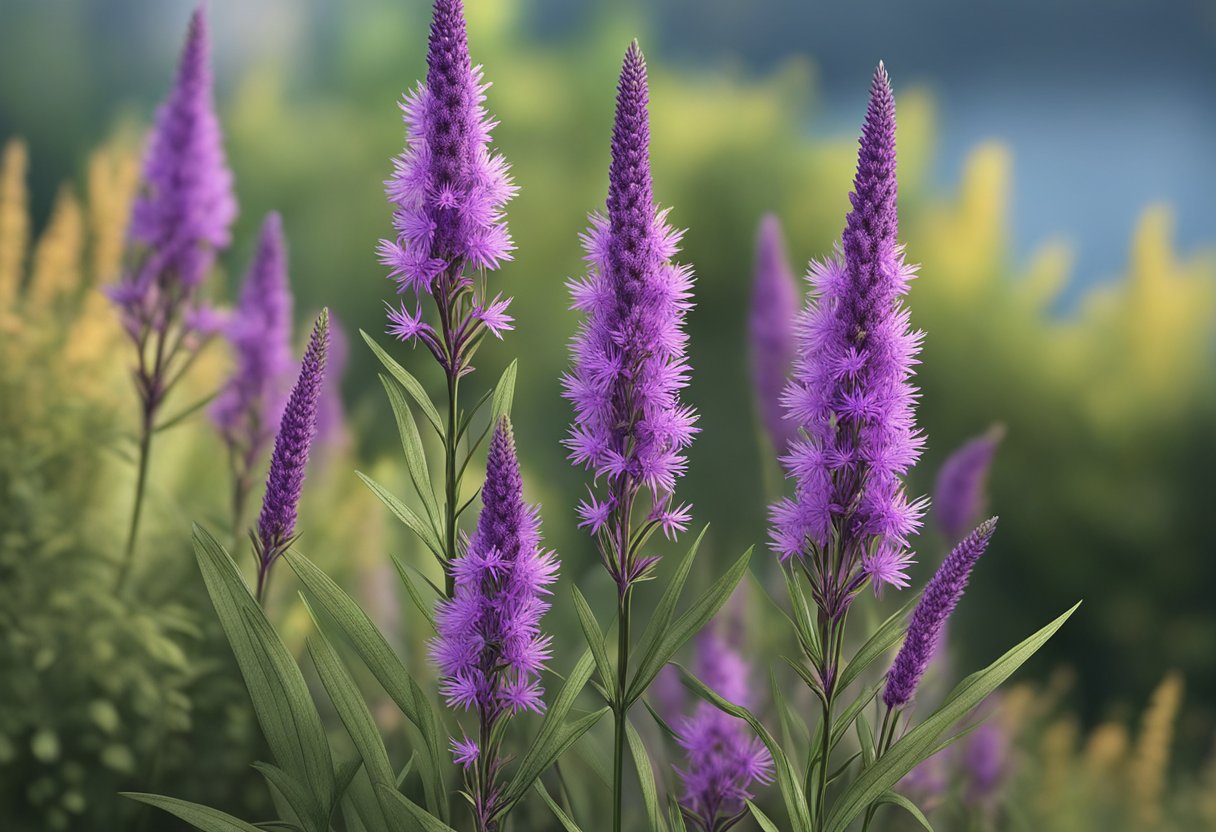Liatris, commonly known as the blazing star or gayfeather, is a striking perennial that captures the eye with its unique bottle-brush flower spikes. As an easy-to-grow plant native to eastern North America, it has an impressive bloom time which is a topic of interest for gardeners and flower enthusiasts. When considering the duration of its flowering season, it’s significant to note that Liatris has a penchant for blooming from late summer to fall, typically showcasing its vibrant flowers for several weeks.

My observations align with experienced gardeners who note that, when planted in early spring, Liatris can start blooming within two to three months, with the display lasting up to four weeks.
Caring for Liatris is straightforward, which makes achieving a lengthy blooming period quite achievable. I plant my Liatris corms in early spring, ensuring they are positioned with the stringy roots facing downward in well-draining soil. A typical flowering period can be expected late in the growing season, although the first year of planting may yield fewer flowers. Subsequent years, however, tend to see a more abundant show as the plants become more established in their environment.
JUMP TO TOPIC
Planting and Propagation of Liatris
Planting and propagating Liatris are essential steps to achieving a vibrant display of these starry flowers. By paying attention to soil conditions, planting times, and propagation methods, you can ensure a successful growth season.
Choosing the Right Soil
For Liatris, well-drained soil is fundamental. I make sure the area doesn’t stay soggy after a rain. Here’s a quick soil checklist:
- Texture: Loamy or sandy soil is ideal.
- pH: Aim for a slightly acidic to neutral pH.
Best Time for Planting Liatris
Planting corms in early spring, once the threat of frost has passed, allows ample time for establishment before summer blooming. However, some gardeners recommend October planting for certain climates.
Propagation Techniques
- Corms: Plant about 2-4 inches deep and 12 to 15 inches apart.
- Seeds: Sow in containers during autumn and expect germination in 15-20 days in cool temperatures.
My first choice is planting corms, ensuring they’re positioned with the pointy end up. If I choose seeds, I prepare for a longer germination period and less predictable outcome.
Caring for Your Blazing Star
Blazing Stars (Liatris sp.) boast a long blooming period and are resilient perennials well-suited for a variety of garden conditions. My experience attests to their hardiness and low-maintenance needs, but some attention to watering and fertilization, along with disease prevention, can ensure they thrive and brighten up your garden with their vibrant spikes.
Watering and Fertilization Needs
Liatris plants are relatively drought-tolerant once established, benefiting from deep, infrequent watering. During the growing season, particularly in the absence of rainfall, I water mine once weekly, ensuring water penetrates deeply to encourage strong root development. It’s crucial not to overwater, as this can lead to rot.
When it comes to fertilizer, less is more; I typically add a balanced, slow-release fertilizer in early spring as new growth appears.
Fertilizing is often unnecessary in rich soils, but if your ground is poor, a light application of a balanced fertilizer will suffice before the onset of the growing season.
Maintenance and Disease Prevention
Regular maintenance tasks for Liatris include deadheading the faded flowers to promote a tidy appearance and potentially encourage a second bloom. I find that dividing the clumps every few years during fall or early spring ensures vigor and helps to prevent overcrowding.
💥 Disease prevention is straightforward:
To avoid powdery mildew and leaf spot, I make sure my plants are spaced adequately to enhance air circulation. If signs of disease appear, I remove affected foliage and apply an appropriate fungicide as needed. Proper site selection with well-draining soil and full sun exposure is key in minimizing disease risks and easing Liatris care.
Liatris Throughout the Seasons
In my garden, Liatris becomes a focal point as it progresses through different stages each season. The plant’s response to seasonal changes is remarkable, especially how it bursts into bloom and readies itself for the colder months ahead.
Spring Awakening
When spring’s warm touch arrives, Liatris begins its growth cycle. In these early months, if the corms were planted, I’ve witnessed shoots breaking through the soil, seeking full sun. This is a crucial time for root establishment and foliage development.
Glory of Liatris in Summer
💥 Bloom Time
Summer showcases the splendor of Liatris as its unique spire-shaped flower heads bloom prolifically. My Liatris often greets the summer with vibrant color within 70 to 90 days from the onset of growth in the spring. These plants thrive in full sun during the summer months, which I’ve found to be essential for optimal blooming.
Preparing for Fall and Winter
In early fall, as the flowering concludes, I prepare the Liatris for dormancy. I’ve learned that cutting back the stems and applying mulch protects the corms through the winter. Mulch serves as an insulator against cold temperatures, ensuring the corms endure until the next spring awakening.
Wildlife and Ecosystem Benefits
Liatris, with its vivid spikes of flowers, plays a crucial role in supporting local wildlife and contributing to the health of ecosystems. It stands out in butterfly gardens, attracting a variety of pollinators.
Attracting Pollinators and Wildlife
Contribution to Local Ecosystems
💥 As a North American native perennial, Liatris contributes significantly to local ecosystems.
It does more than provide food; it’s an integral part of the habitat. I’ve noted that it stabilizes soil and helps prevent erosion due to its clump-forming nature. It’s a hardy plant that, once established, sustains itself and the surrounding flora and fauna, thus supporting biodiversity in my region.












